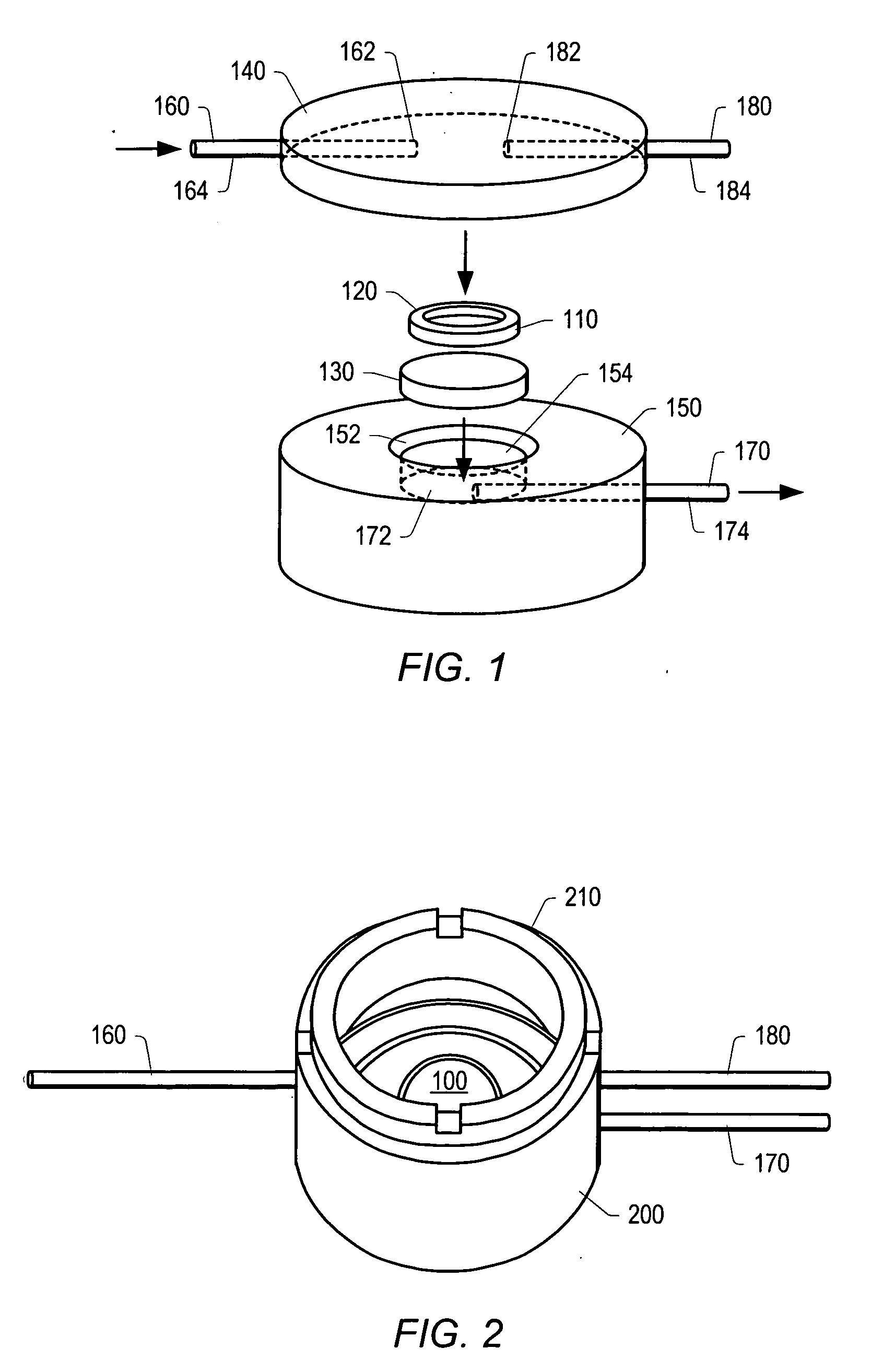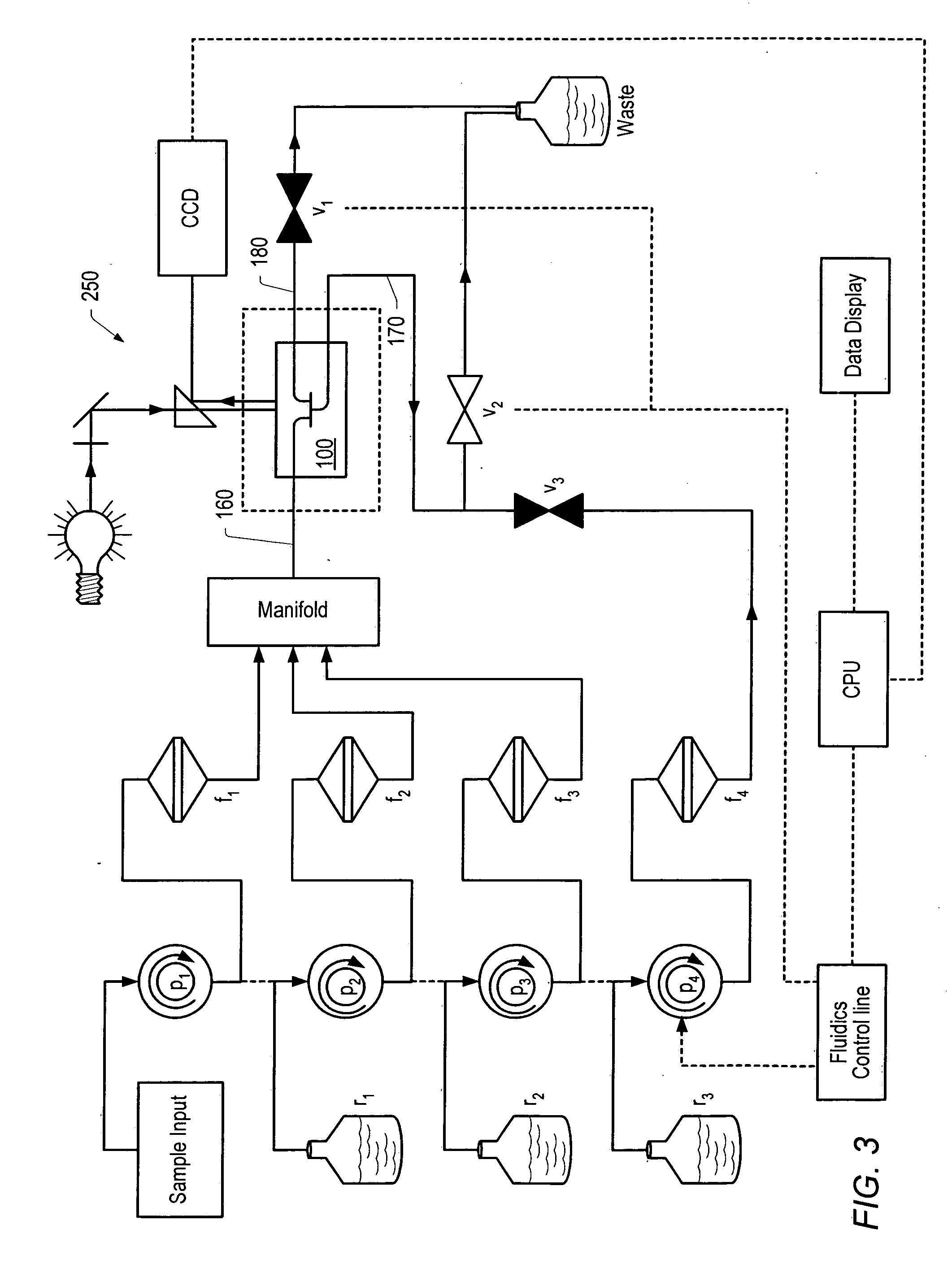Microchip-based system for hiv diagnostics
a technology of hiv diagnostics and microchips, applied in biochemistry apparatuses, instruments, peptides, etc., can solve the problems of requiring more cumbersome processing methods and detection equipment, and achieve the effect of enhancing detection of small molecules, reducing blood sample volume, reagent and power requirements, and enhancing detection
- Summary
- Abstract
- Description
- Claims
- Application Information
AI Technical Summary
Benefits of technology
Problems solved by technology
Method used
Image
Examples
example 1
Microchip-Based Assay for Measurement and Quantification of CD4+ T Cells
Design and Development of Flow Cell Analysis Chamber
[0142] A chip-based sensor array composed of individually addressable microwells on a single silicon or plastic microchip has been developed. Microwells were created using molded-plastic methods, optimized, and the resultant structures, made with an anisotropic etch, served as miniaturized reaction vessels and analysis chambers. Each microwell has a volume of approximately 30 nanoliters (nL); a single microliter (μL) of fluid provides sufficient sample to complete multiple assays. Microwells possess pyramidal pit shapes, with openings that allow for both fluid flows through the analysis chambers as well as optical analysis of reactions occurring on the floor of the microwell, or on microbeads or a membrane filter resting within the microwell. Current chips contain up to 100 microwells on a single, dime-sized chip (FIGS. 7 and 8).
[0143] The microchip is anch...
example 2
Measurement of CD4:CD8 Ratios and CD4+ Percentages from Whole Blood
[0152] A rapid, whole blood assay (without red blood cell lysis, extra buffers or additional sample processing) for detecting CD4+ and CD8+ cells and establishing CD4:CD8 ratios was developed, based on the microchip discussed in Example 1. Adjustment of the flow parameters and dilution of the sample revealed an optimal flow rate of 0.8 mL / minute and a dilution of whole blood of 1:20.
[0153] The blood was obtained by venipuncture from healthy volunteers or HIV-infected subjects at the Massachusetts General Hospital and the Botswana-Harvard Laboratory in Gabarone, Bostwana. For the measurement of CD4:CD8 ratios and CD4+ percentages, 33 microliters of whole blood was mixed with 3 microliters of fluorophore-conjugated antibodies to CD3, CD4 or CD8 for staining. An optimized staining protocol was established for each of the antibodies utilized in this study by performing tube reactions and on-slide observation of the res...
example 3
Microbead Immunoassay
[0160] Agarose microbeads were coated with antigens specific to a variety of pathogens, including HIV gp41 / gp120, HIVp24 and hepatitis B surface antigen. Beads coated with antibody to specific antigens were placed in the wells of a silicon microchip and serum samples containing known titers of antibodies were then run through the microchip system, and detected by fluorescence microscopy using Cy2-labelled secondary antibodies. FIG. 13 shows results of one such experiment; with serum containing antibodies against HIV and hepatitis B easily detected using the microchip approach.
[0161]FIG. 15 shows the results of another microbead experiment where the HIV p24 antigen was detected in human serum containing 100 pg / ml of HIV p24 antigen. The same principle can be applied to any immunoassay, including liver enzymes.
PUM
| Property | Measurement | Unit |
|---|---|---|
| volume | aaaaa | aaaaa |
| dead volumes | aaaaa | aaaaa |
| thickness | aaaaa | aaaaa |
Abstract
Description
Claims
Application Information
 Login to View More
Login to View More - R&D
- Intellectual Property
- Life Sciences
- Materials
- Tech Scout
- Unparalleled Data Quality
- Higher Quality Content
- 60% Fewer Hallucinations
Browse by: Latest US Patents, China's latest patents, Technical Efficacy Thesaurus, Application Domain, Technology Topic, Popular Technical Reports.
© 2025 PatSnap. All rights reserved.Legal|Privacy policy|Modern Slavery Act Transparency Statement|Sitemap|About US| Contact US: help@patsnap.com



